Polychrome porcelain basket forming an inkwell, signed Jacob Petit. It is covered with a multitude of flowers in relief: violets, tulips, chrysanthemums, roses and several varieties of petunias. This piece is highly characteristic of the master's original, whimsical style, with the extraordinary abundance of plants, the contrast of bright colors and the delicate, meticulous workmanship of the petals. A rose and a chrysanthemum conceal the two ink cups, topped by bees. Marked "JP" in blue under the base. Jacob Mardochée, known as Petit (1796-1865) began by studying painting in Gros's studio, before travelling extensively to Italy, Switzerland, Germany and England, where he settled for several years, studying various industries while painting theater sets. On his return to France, around 1830, he published a collection of one hundred interior decoration plates with models of vases, furniture, goldsmiths' and silversmiths' pieces and woodwork in which earlier styles were visited, with a preference for Antiquity and the Gothic style. After a short stay at Sèvres, he set up a small workshop in Belleville, then acquired Baruch Weil's porcelain factory in Fontainebleau, which he moved to Avon a few years later. This was one of the most famous porcelain factories of the 1830s-1860s, owing its fame to the choice of rocaille forms inspired by Saxon porcelain. This highly eclectic porcelain maker's style is characterized by the accumulation of elements from earlier styles. Troubadour Gothic, Renaissance, Neoclassical, Rocaille and Far Eastern styles can be found alone or in combination. Contoured forms, vivid polychromy and an abundance of decorative elements contrast with the sobriety inspired by Antiquity. Criticized or admired in their own time, Jacob Petit's production gave rise to numerous imitations by various manufacturers. Authentic pieces bear his "JP" mark in blue or debossed. Bibliography: Régine de Plinval de Guillebon, "Jacob Petit, le plus romantique des porcelainiers parisiens", L'Estampille/L'Objet d'art, n° 311, March 1997, pp. 48-57. XIX° period, Circa: 1850 Dim: W:26cm, D:17cm, H:12cm.
- Reference :
- 1899
- Availability :
- Sold
- Width :
- 26 (cm)
- Height :
- 12 (cm)
- Depth :
- 17 (cm)
- Identifier Exists:
- False


























